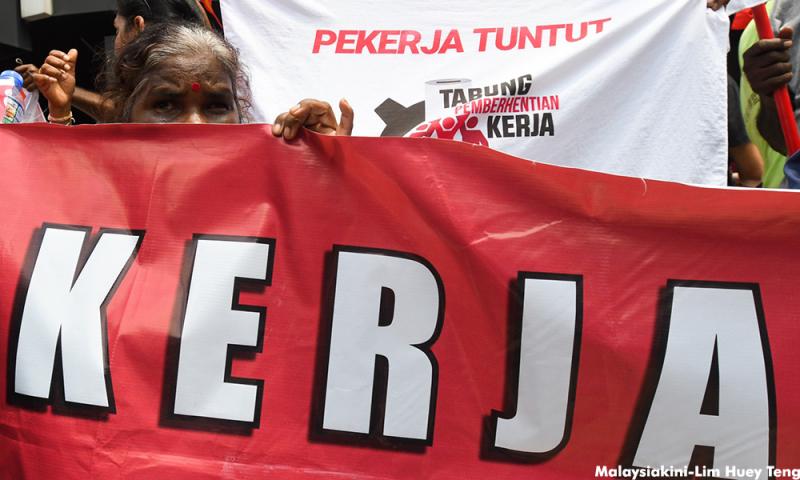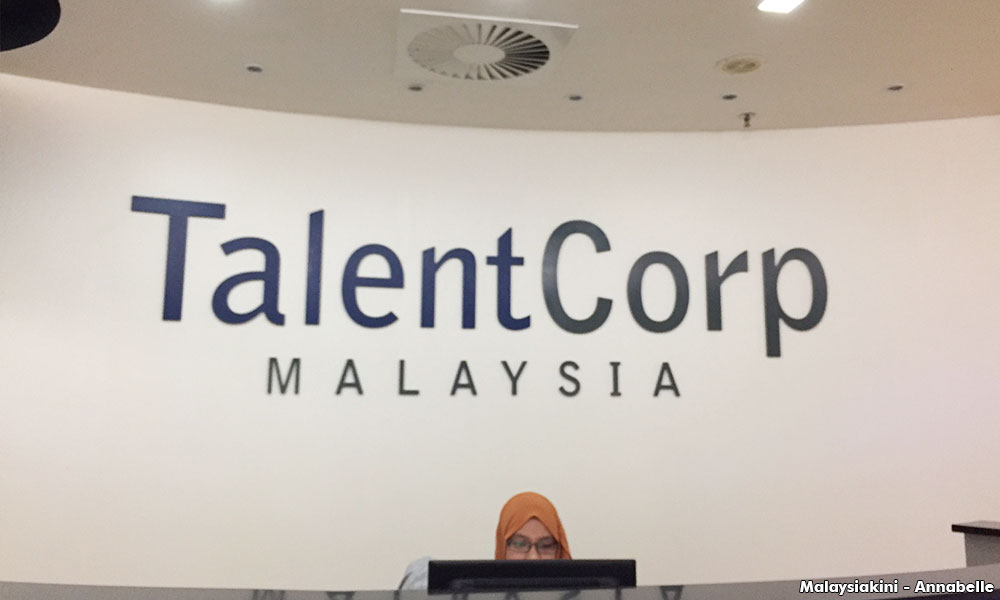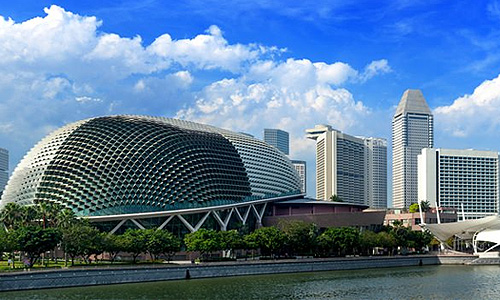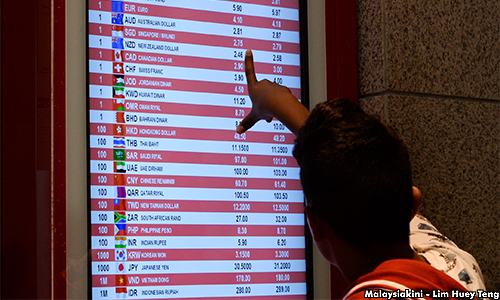Working For A Reasonable Wage

COMMENT | On 25 May 2017, a tragedy occurred involving a Malaysian citizen on a bridge that separates two nations with a composition of foreign workers of different faces. A man felt discomfort and died on a lane.
Before discussing the details of the tragedy, let us look into the situation of Malaysians who are either working or unemployed on their own soil.
According to the Department of Statistics Malaysia, it was estimated that Malaysia had a labour force of 14.7 million with a labour force participation rate of 67.7 percent in 2016.
There were 14.2 million of working population while there were 504,100 being unemployed. The unemployment rate in 2016 rose by 0.3 percent to 3.4 percent of the total labour force comparing with 3.1 percent in 2015.
The largest contributor to the unemployment figure was the age group of 20-24 years, which made 37.7 percent of overall unemployment. This figure is followed by the age group of 25-29 years with 22.7 percent of them, and 16.5 percent for the age group of 15-19 years.
As for the unemployment rate, the age group of 15-19 years recorded the highest unemployment rate which was 15.9 percent, followed by the age group of 20-24 years with 9.1 percent, and 4.2percent for the age group of 25-29 years.
These statistics bring us two important messages, that is, the unemployment rate in Malaysia is high and the unemployed are mostly young people.
According to the definition by The Organisation for Economic Co-operation and Development (OECD), the unemployment rate refers to the number of unemployed people as a percentage of the labour force.
Unemployed people are those who report themselves as jobless but ready to work and have actively looked for jobs in the past four weeks.
Unemployment remains an economic issue that needs to be handled immediately. As obtained, the unemployment rate is on the rise from year to year. From year 2012 to 2016, the year 2016 recorded the highest unemployment rate which was 3.4 percent whereas the lowest unemployment rate was recorded in 2014 which was only 2.9 percent.
The unemployment rate is an important indicator of a country’s economic performance.
A high unemployment rate shows that the economic growth in Malaysia is unsatisfactory and the labour market is inactive.

However, Minister of Human Resources Richard Riot (photo) said that the unemployment rate in Malaysia is under control and expected not to exceed 3.5 percent in 2017 due to the global economic recession.
According to him, Malaysia has always been one of the countries with the lowest unemployment rate at 3.1percent. Besides that, he also said that according to the benchmark set by OECD, an unemployment rate below 4percent is considered as a full utilisation of labour force.
It is understood that under the 11th Malaysia Plan (11MP), the government has outlined the economic agenda to produce human capital that contributes to economic growth and competes with the global economy. The initiative is projected to produce 1.5 million workers in 2020.
However, from 2014 to 2016, job opportunities in Malaysia overall only increased by 631,600 jobs. The resulting projection for 2020 based on this data estimates the creation of around 1.05 million jobs, which is 30percent lower than the projection by 11MP. So, does this job creation overcome unemployment?
The latest official information by the Department of Statistics showed that from 2014 to 2016, job opportunities in Selangor increased by 305,300 jobs, which was from 2,912,300 jobs in 2014 to 3,217,600 jobs in 2016.
During the same period, as previously mentioned, job opportunities in Malaysia increased by 631,600 jobs overall, which means that the increase of 305,300 jobs in Selangor comprises nearly half or 48.3 percent of the overall increase in job opportunities in Malaysia from 2014 to 2016.
Nevertheless, the current unemployment rate in Malaysia is considered high as compared to our neighbours, for instance Singapore and Thailand. It was 3.4 percent in Malaysia while the other two countries each recorded 2.1 percent and 0.75 percent in 2016.
Youth unemployment
Unemployment among young people is also quite worrying. Research findings by the Bank Negara in their 2016 annual report which was published on 23 March 2017 found that the youth unemployment rate (15-24 years old) in Malaysia had reached 10.7 percent in 2015, which is three times higher than the national unemployment rate of 3.1 percent.
This research also discovered that more than half (61 percent) of the total number of unemployed persons were young people, despite being merely one-third of the total labour force.
This research also showed that the youth labour force mostly consists of those who have received lower levels of education, which was about 84 percent, while only 16 percent of them were youths who had undergone tertiary education.
Additionally, the unemployment rate among youth with tertiary education was higher (15.3percent) than youth who did not receive tertiary education which was 9.8percent. This shows that unemployment among graduates was higher than non-graduates.
Before this, the “State of Households II Report” by Khazanah Research Institute (KRI) showed that the majority of the unemployed was higher educated people. The report stated that 33.8 percent of the unemployed were higher educated in 2015.
Besides that, tracer studies by the Ministry of Higher Education (MOHE) showed that about 25 percent of the 254,161 students who completed their studies in 2014 remained unemployed even after six months. The young people aged 20 to 24 years and aged 25 to 29 years became the largest unemployed group.
Other than that, research findings by the MOHE and online job portal JobStreet regarding local fresh graduates and their employment patterns in 2016 also showed that one out of four fresh graduates in Malaysia had been unemployed for six months after graduation and one out of six who were unemployed were below the age of 24.
As a conclusion, these studies stressed that unemployment is a serious issue among young people especially graduates. This questions the quality and the suitability of our education system in producing graduates that meet the needs of Malaysia’s industries.
Surprisingly, those who receive higher education are facing more difficulties in finding a job. They also need to participate in various retraining programs by the government to enhance their skills. Examples are the 1Malaysia Training Scheme (SL1M) and the Graduate Employability Management Scheme (GEMS).
The SL1M which was launched on 1 June 2011 is an employability programme which aims to help unemployed graduates improve their ability by equipping them with knowledge, skills and working experience, thus increasing their chance in getting a job.

GEMS, which is conducted by Talent Corporation Malaysia Berhad (TalentCorp), also aims to increase the graduates’ employability in order to overcome shortages in skilled labour in major economic fields by 2020. This programme will equip fresh graduates and unemployed graduates with skills which are needed by the industry.
Therefore, is the problem merely the poor quality of the graduates due to the declining quality of education in Malaysia?
We at the Political Studies for Change (KPRU) wish to raise the issue of a lack of direction in the transformation of the national education system, so that youth unemployment can be assessed more thoroughly.
There is also a need to redefine academic education vis-a-vis non-academic education, without which the whole exercise of transforming the education system will continue to revamp an existing education system which is basically academic.
Retraining is important in helping unemployed graduates to find a job, but it does not solve graduate unemployment in a long run. If graduates receive training and learning which is of good quality and useful during their tertiary education, they should have been equipped with abilities and skills which are competitive in the working world without the need of retraining.
Therefore, the cause of unemployment among graduates is said to be the quality of education in our country which is unable to produce quality, employable and competitive graduates.
However, when explored in detail, the lack of direction in the transformation of the national education system has contributed to the phenomena of graduates failing to get a job and having to be retrained. Such lack of direction is due to the lack of differentiation between academic education and non-academic education in the national education system.
What is the quality of education to be conveyed through academic institutions, and what is the quality of education to be conveyed through non-academic institutions such as technical and vocational education?
To what extent has the national education system differentiated the roles of academic institutions and non-academic institutions? To what extent have these two get jumbled up?
Since it is important for graduates to be equipped with necessary knowledge and it can be learned through technical and vocational education, why is the attention on such institutions far behind the academic institutions?
Current measures to revamp the education system still demonstrate the lack of differentiation between academic institutions and technical institutions.
Although on paper it seems that the government has been promoting non-academic education (technical and vocational), in reality, non-academic education will continue to struggle for existence. Malaysian society will continue to ignore the importance of non-academic education by assuming that academic education will provide all necessary ingredients.
Due to such issues, the young people remain as the group of people who are most easily affected in the labour market. They tend to be labelled as people who are new to working and lack experience and various necessary skills.
Employers are not interested in hiring fresh graduates and they become targets whenever the companies wish to downsize the workforce.
Also due to such problems, the cultivation of values and preparations of graduate minds are contradictory to the values in the market and capitalist economy which is the backbone of the labour market in Malaysia.
The preparation of graduates from various aspects which are needed in the capitalist working world in line with the context of technological development, is also weak in the education transformation as flaunted.
What is more worrying is that the preparation of high quality jobs with a reasonable wage shows an obvious shortage up to the extent that Malaysians are either jobless or becoming foreign workers in other countries, while low quality jobs with an unreasonable wage are everywhere in the country.
A continuing tragedy
Various factors contributed to unemployment. Certain quarters claimed that failure of local workers in getting a job is due to a large incoming of foreign workers.
According to the Employment and Labour Statistics Series 11, No. 1/2017 March, by the Ministry of Human Resources (MOHR), up to 31 December 2016, Malaysia had 1,866,369 foreign workers which were mostly from Indonesia, Nepal, Bangladesh, Myanmar and India.
They are usually involved in the manufacturing, construction, plantation, agriculture and service sectors. As mentioned, the number of foreign workers in our country is high but official statistics said they are only 13.2 percent of the working population of Malaysia.

On the other hand, Singapore has 1,393,000 foreign workers up to December 2016. The percentage of foreign workers over there is 37.9 percent of the working population of Singapore.
We can say that job competition between foreign workers and local workers in Singapore is greater than in Malaysia. Despite that, Singapore still maintains a lower unemployment rate than Malaysia, which was 2.1 percent in 2016.
Therefore, unemployment in Malaysia is not necessarily caused by foreign workers, but due to the government’s policy in creating job opportunities with high quality or with a reasonable wage for the people.
However, we cannot deny that the intake of foreign workers with a lower wage being offered comparing with local workers, caused employers to prefer hiring foreign workers. More Malaysians are unable to find jobs and some of them have to accept a lower wage in order to get employed.
The reality is, this is due to the cheap labour policy that discouraged wages from increasing, and resulted in competition against local workers. Due to the unsatisfactory wage offers in Malaysia, many Malaysian workers choose to work overseas such as Singapore and Australia where they can earn more.
According to news reports, there are more than one million Malaysians working overseas, especially in Singapore. 300,000 Malaysians travel to and fro daily between Johor Bahru and Singapore.

Since the exchange rate of Singaporean dollar (SGD) is on the rise as compared with Malaysian Ringgit (MYR), there are more Malaysians wanting to make a living in Singapore.
Even though they have to travel to and fro Singapore and bear the risk of accident on a daily basis, Malaysians remain working in Singapore for the sake of a higher pay in order to cover their expenses and family responsibilities.
As a result, such tragedies as mentioned in the beginning of this article keep happening.
As reported in the press, on 14 April 2017, a 56 years old man, Yam Kok Kong, who travelled to and fro Singapore to work since 18, died on his way home while passing through a lane in the Secured Automated Clearance System for Malaysian Citizen Motorcyclists (M-Bike) in the Sultan Iskandar Building Customs, Immigration and Quarantine (CIQ), Gelang Patah, due to a heart attack.
On 23 May 2017, a father aged 30 who had also been travelling to and fro Singapore to work, died in a road accident. He had been working in Singapore for about seven years and had a wife and four children.
On 25 May 2017, there was another case where a man felt discomfort and died at the 100th km in the Malaysia-Singapore Second Link, while on his way back to Johor.
Unsatisfactory wages
Deputy Prime Minister Ahmad Zahid Hamidi said that the influx of many foreign workers into our country is because there are not many Malaysians ready to work in the 3D sector (dirty, difficult and dangerous) despite being offered good pay and benefits.
What are the good pay and benefits being mentioned?
Based on the deputy prime minister’s views, Pertubuhan Rapat Malaysia President, A Rajaretinam said that Malaysians are unwilling to take up 3D jobs in Malaysia because of low pay. Records showed that there were 600,000 Malaysians working in the 3D sector in Singapore.
The problem is that for the same job, they are being paid RM900 per month in Malaysia while in Singapore they are being paid S$1,000 per month, which is at least RM3,000 based on the current exchange rate.
In an interview by Malaysian Insider, a Malaysian named Zul who is working in Singapore said that it is not true that Malaysians are not willing to take up 3D jobs.
Every day there are graduates travelling to and fro between Johor Bahru and Singapore to do jobs which are taken up by foreign workers in Malaysia.
This is because the salary in Malaysia is insufficient whereas they can get better pay in Singapore.
It is clear that taking in foreign workers is not the way to solve the problem, but the government should focus on the problem with wages by offering a more reasonable and fairer wage to the workers.
Local workers are willing to work in the 3D sectors if the pay is reasonable. Therefore, our country does not need so many foreign workers and unemployment can be overcome.
A Guide On Starting Wages: 160 Selected Skills Jobs, First Edition (2016) is being published by the MOHR. This guide involves majority of the jobs in the technical and vocational fields, and the content will be reviewed and updated every two years in line with the review of the Minimum Wage Order 22.
The starting basic salary rate for five levels of skills which are MSC T1, MSC T2, MSC T3, MSD T4 and MSAD T5 which involves Malaysian Skills Certificate (MSC), Diploma (MSD) and Advanced Diploma (MSAD), are being recommended.
For MSC T1, the starting basic salary is RM1,130, MSC T2 is RM1,250, MSC T3 is RM1,510, MSD T4 is RM1,830 and MSAD T5 is RM2,270.
From this guide on starting wages, it is found that the starting wages being offered to the skilled jobs are quite low. If this is the starting pay for skilled workers, what about the semi-skilled and unskilled workers?
It is obvious that the salary level in our country is low and this does not show an adequate increment even after the implementation of the minimum wage, and might be influenced by the minimum wage being set by the government.
On 1 July 2016, a Minimum Wage Order was enforced. The monthly minimum wage to be paid to an employee has to be RM1,000 for Peninsular Malaysia and RM920 for Sabah, Sarawak and the Federal Territory of Labuan.
Although this minimum wage was meant to boost employees’ income and protect their interests, the outcomes were not as expected. Some companies were unable to continue hiring employees and had to retrench some of them, and some of them even kept bullying their employees by reducing other benefits.
Besides that, we must understand that this minimum wage does not mean that an employee’s salary must start at this minimum rate or can be suppressed and reduced as long as it is at the minimum rate. Unfortunately, most of the jobs offer a salary which is not in line with the type of jobs.

Since the implementation of the goods and services tax (GST), goods prices and service fees have never been reduced as once expected by the minister, in fact a price hike beyond market logic has been happening all over the country.
Furthermore, under such a slow economic condition and the shrinking value of the Malaysian ringgit, the people’s livelihoods are getting tough, especially for the lower and middle income groups.
Studies by KRI showed that inflation in food prices in Malaysia is higher than the overall inflation. Between 2011 to 2015, food prices inflation was 3.6percent in average, while the overall inflation was 2.4percent. The people have to bear a high living cost with a stagnant salary, or a salary which is not increasing reasonably. If they lose their jobs, their families’ livelihoods will be affected.
We expect the GST to be raised after the 14th general election, as has happened before in other countries. Therefore, in our opinion, the minimum wage should be raised to RM1,500 per month and the salary raised in all industries without discriminating against Sabah dan Sarawak.
Nevertheless, at the same time, we understand that employers are also facing difficulties in running their businesses and wish to save cost in order to generate more profits. After all GST not only affects the consumers but also businessmen. Many businesses have had to be closed down due to GST, especially those owned by senior citizens.
In order to handle this dilemma, we suggest that the government should play a role in helping employees and employers to face such a difficult life.
In line with the policy of increasing wages, the government can give incentives to employers so that they can adjust themselves to the increase in wages, and also provide aid to expand their businesses.
We believe that paying a reasonable and fair wage may solve unemployment and benefit the national economy and also the employers.
Ooi Heng is executive director of the think tank Political Studies for Change (KPRU).
Elijah Khor and Saw Jia Ying are research officers at KPRU.
News from Malaysia Kini


